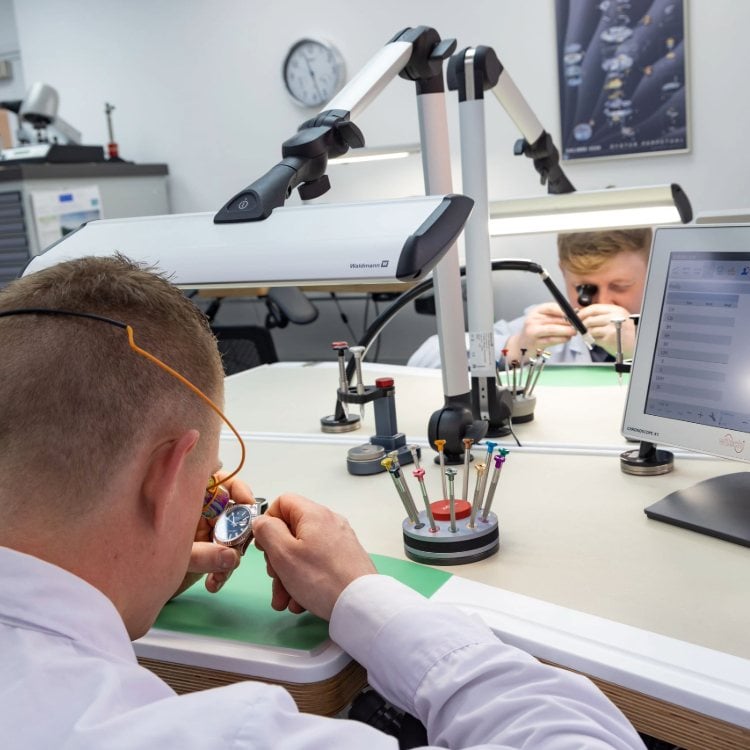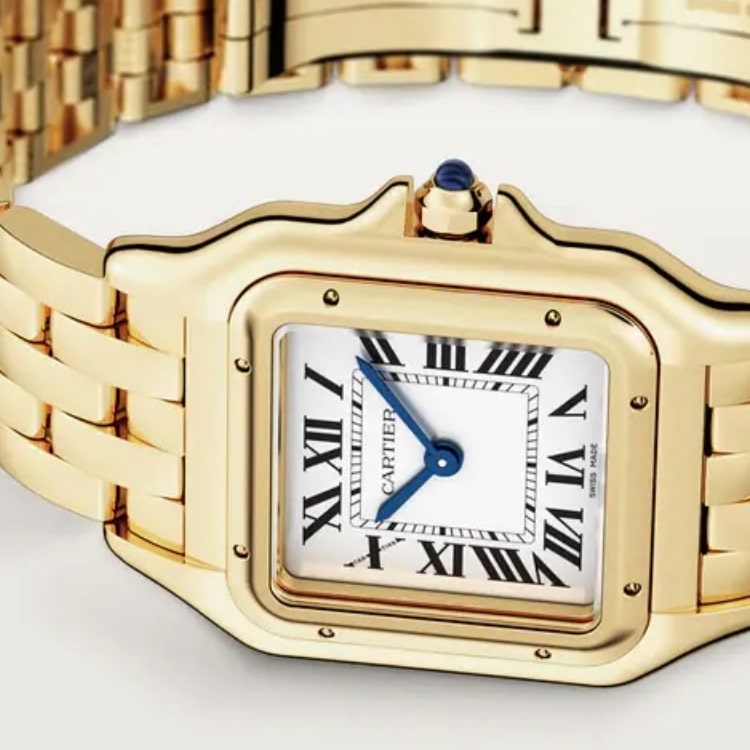Watch Servicing, Repairs and Restoration
Regular servicing is essential for maintaining the precision, performance, and longevity of your watch. Most manufacturers recommend servicing every four to seven years to prevent wear and maintain water resistance.
At Pragnell, we offer more than just routine servicing. Our expert team can service your Rolex at our Rolex-accredited service centre in our Leicester showroom and we offer comprehensive watch repairs for many brands, including Patek Philippe, Cartier and Jaeger-LeCoultre, as well as specialist restoration for vintage, pocket, and heirloom timepieces. All services can be booked at any of our showrooms in Stratford-upon-Avon, Mayfair and Leicester, where your watch will receive the highest standard of care and attention.
Watch Maintenance
To keep your watch performing at its best, we offer a range of maintenance services that ensure precision, durability, and everyday wearability.
-(1).jpg)
Lubrication and Regulation
Over time, the oils within your watch can degrade or dry out, causing increased friction and wear. Refreshing these lubricants and regulating the timekeeping mechanism helps maintain accuracy.
Water Resistance Maintenance
The gaskets and seals that prevent moisture from entering your watch can degrade with age. As part of regular maintenance, inspections and tests are conducted to ensure your watch remains properly sealed and protected.
Quartz Watch Servicing
Quartz watches still have many mechanical components. Our services include battery replacement, lubricant reapplication, and movement regulation to ensure accurate and reliable operation.
-(1).jpg)
Strap Replacement and Customisation
Choose from luxury leather or metal straps, with a selection of clasps, stitching, and finishes to personalise your timepiece.
Cleaning and Resizing
Light polishing, strap resizing, and general cleaning are all part of routine upkeep that helps your watch look and feel its best.
Turnaround Time
The time required for servicing a watch can vary based on the brand, model, and the type of service needed. Our watch experts can give you an initial assessment. If you decide to proceed, we will send your watch to the brand for a detailed evaluation. Following this evaluation, we will provide you with an estimated timeframe for completion and the associated service cost.
You can conveniently drop off your watch at any of our showrooms located in Stratford-upon-Avon, Mayfair, or Leicester.
-min.jpg)
Battery Replacement
Every quartz watch will eventually require a battery replacement. The lifespan of the battery depends on several factors, including the watch's age, the condition of its movement, the type of watch (analogue, chronograph, or digital), and its additional functions. Watches with more functions typically require more frequent battery replacements.
If your watch has a second hand, you may notice it jumping two to four seconds, which indicates that a battery change is approaching. If the watch stops due to a dead battery, it is essential to replace it promptly to prevent chemical leakage, which could damage the movement.
You can have your watch battery changed at any of our showrooms located in Stratford-upon-Avon, Mayfair, or Leicester. Prices for battery replacements start at £15.
Watch Repairs
When damage occurs, expert repair is essential to restore your watch’s function and preserve its longevity. You can find detailed information about our watch repair services below.

Water Damage Repair
Moisture inside your watch can cause severe internal corrosion. The case will be disassembled, contaminants removed, damaged parts replaced, lubrication performed, and the case resealed to prevent further issues.
Glass Replacement
Scratches or cracks in the crystal can impact visibility and water resistance. Full glass replacement is offered using original or brand-specified components.
Case refinishing
Every day wear can leave your watch case looking worn out. The refinishing service restores the original finish using expert polishing techniques to preserve the piece's original beauty.
-(1).jpg)
Component Repairs
If internal mechanisms are damaged, affected parts are replaced or repaired using genuine or manufacturer-approved components to ensure precision and durability.
Turnaround Time
The duration for watch repairs can differ depending on the brand, model, and specific repairs needed. Our skilled watch experts can provide an initial assessment. If you choose to move forward, we will send your watch to the manufacturer for a thorough evaluation. After this assessment, we will inform you of the estimated time for completion and the associated repair costs.
You can easily drop off your watch at any of our showrooms located in Stratford-upon-Avon, Mayfair, or Leicester.
Watch Restoration
Preserve the value and character of your vintage, pocket, or heirloom timepieces with our traditional restoration services. Detailed information on our restoration offerings can be found below.

Vintage Watch Servicing
Older timepieces often require more delicate handling. We work closely with the brands or specialist vintage restorers who use time-honoured techniques to preserve the integrity of your watch while restoring its function.
Pocket Watches and Clocks
From family heirlooms to collectable antiques, we offer full servicing for pocket watches and clocks, ensuring accuracy and careful preservation of original components.
Part Re-manufacturing
If a part is no longer available, it can be recreated using traditional methods to ensure authenticity and compatibility with the original mechanism.
-(1).jpg)
Preservation Work
Beyond repair, restoration focuses on preserving the charm, age, and provenance of your timepiece, striking a balance between performance and respect for its history.
Turnaround Time
The time required to restore a watch can vary based on the brand, model, and specific type of restoration needed. Our team of watch experts will begin with an initial assessment. If you decide to proceed, we will send your watch to the manufacturer for a thorough inspection. After this evaluation, we will provide you with an estimated timeline and cost for the restoration process. Generally, vintage watch restorations take a minimum of 16 to 20 weeks, while modern watch restorations take about 4 to 6 weeks.
You can conveniently drop off your watch at any of our showrooms located in Stratford-upon-Avon, Mayfair, or Leicester.

Rolex Accredited Service Centre
Safeguard your Rolex by bringing it to our Rolex-accredited service centre. Our authorised watchmakers use genuine parts and manufacturer-approved tools to service and repair your watch. Each timepiece is treated to the same exacting standards you would expect from the manufacturer and is returned to you in pristine condition. Additionally, every service is backed by a comprehensive warranty, providing you with lasting peace of mind.
Watch Guides
Discover more about watches.
Watch CLP Page
Contact us

